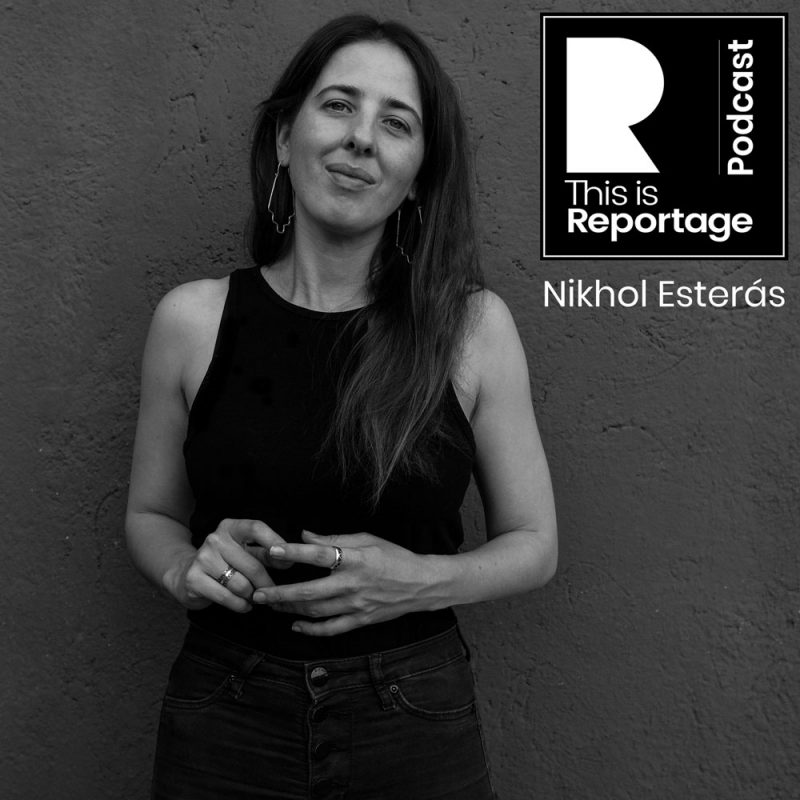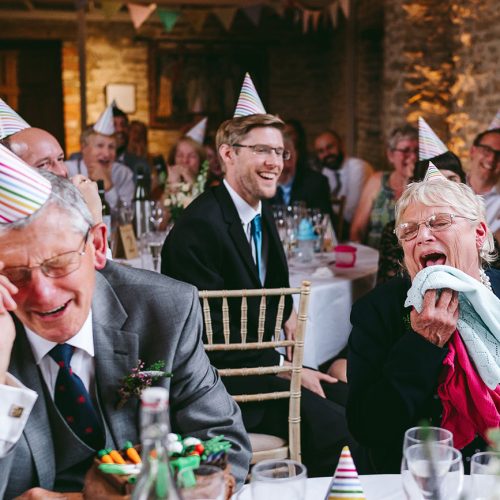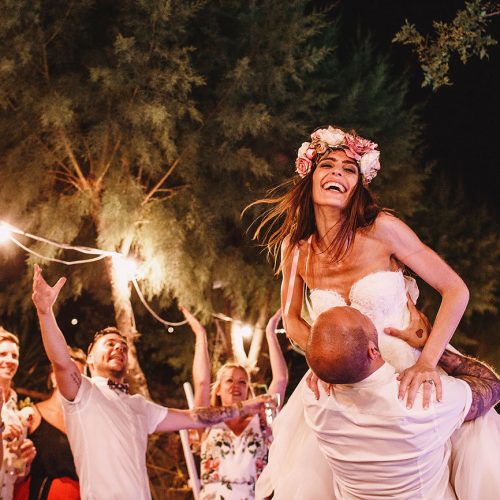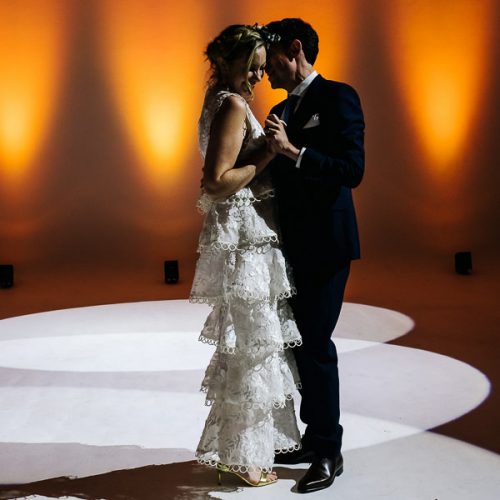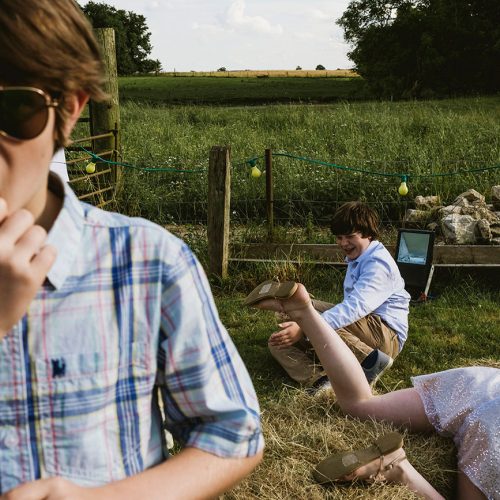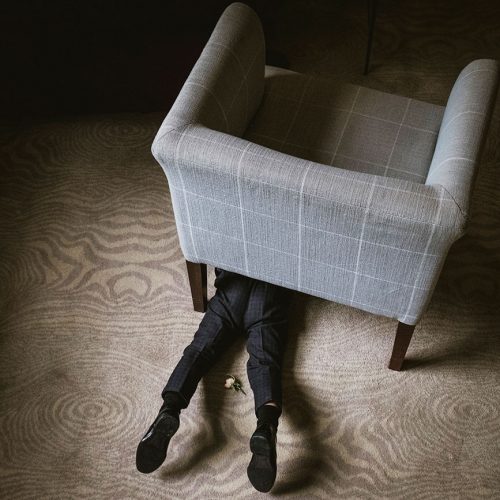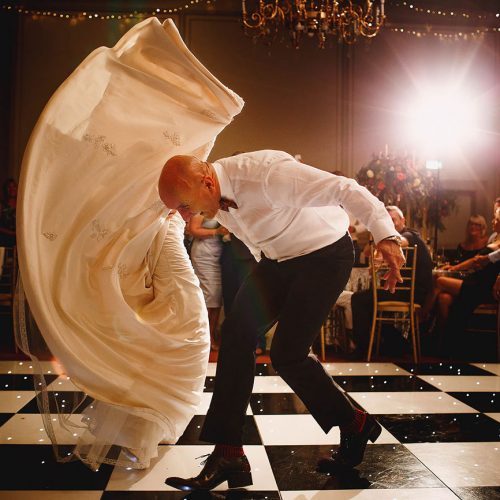Podcast Episode 39: This is Nikhol Esterás
Excited to be talking to the fab Nikhol Esterás for episode 39 of the This is Reportage Podcast today! One of the very best wedding photographers in Mexico, Nikhol has won a staggering 12 awards from us, including 5 Story Awards, and was ranked in our Top 50 photographers of 2019. In this episode Nikhol shares all about:
- how she got into wedding photography,
- working with her husband and the benefits of that,
- how their backgrounds in art and psychology have affected their photography,
- dealing with the effects of covid,
- travelling in their VW bug, and their photoseries during covid from within that,
- some TV series recommendations (Dark! Watch Dark, everyone!)
- what time she would travel to if she had a time machine,
- tips on submitting to the Story Awards,
- the pronunciation of reportage,
- the importance of observation and getting to know people,
- what success means to her,
- what’s been good sources of bookings for her,
- how she does her video meetings with couples,
- the importance of practice,
- how she approaches family photography in the same way as weddings,
- advice for if you’re feeling stagnant,
- why olives aren’t her favourite thing,
- what happiness is to her,
- and much more…
Listen on Spotify, iTunes/Apple Podcasts, Google Podcasts, YouTube, and below with a full transcript if you prefer to read.
Alan:
Hey Nikhol, how you doing?
Nikhol:
Hey good Alan, how about you?
Alan:
Yeah, all fine, all fine, thanks. Yeah, how are things with you, because you’re in Mexico aren’t you? What’s the weather like with you at the moment?
Nikhol:
Yes, so I’m in Southern Mexico in the state of Oaxaca, and the weather is nice right now, beautiful day so far, we’ll probably have some rain in the afternoon.
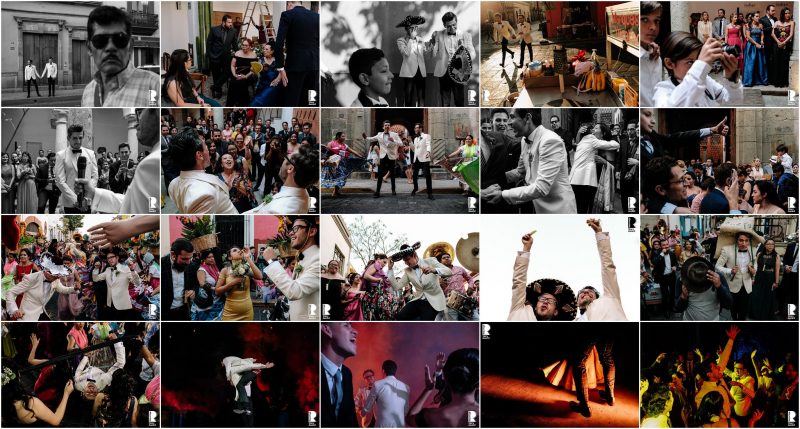
Alan:
Oh, okay cool, I’m in not very sunny England which has been raining all day.
Nikhol:
Oh man, how long does it rain for? Is it like all summer?
Alan:
Yes. I think we’ve had our summer because we had one day of sunshine in June and now it’s just been raining.
Nikhol:
Oh man, that’s rough.
Alan:
Have you ever been over to England?
Nikhol:
I haven’t actually, my husband, he was there he did an artist residency there in 2015. So, he was there for a couple months. He was out in the countryside though, and I think I’m going to pronounce this incorrectly, but it’s Cirencester or something like that.
Alan:
Do you know what? I think I pronounce it incorrectly.
Nikhol:
I don’t even think I ever figured out how to pronounce it correctly where he was, but he was out in the countryside for a residency, an artists’ residency, for like two months living out there. And then he was travelling, but he was in London and then I don’t remember where else he went. But no, I personally haven’t been there. I’d love to someday. I have some really close friends of mine who I actually met, and Oaxaca are from London, though.
Alan:
Oh, cool, oh okay. Yeah, you should come over one day, and I need to go to Mexico I’d love to go to Mexico, never been.
Nikhol:
Oh, that’s best. I’m biased, but you should come to Mexico, it’s awesome. There’s so much, you know, like, so much to see and do. It’s a beautiful country.
Alan:
I need to come someday. And you mentioned your husband there, and I think you shoot with him, don’t you?
Nikhol:
Yeah.
Alan:
So how did that… How did that happen? How did you come to work together? You know, do you have like separate distinct roles on the day, you know, do you ever argue or disagree? How did that happen?
Nikhol:
Yeah, those are all great questions. So, we both started out in documentary photography and in the context of nonprofits. So, we’re doing documentation of the work that they were doing in Nayarit first, in the state of Nayarit in Jalisco and then on the coast, the west coast. And then we moved back to Oaxaca, we’re both working in nonprofits as well as documenting the programs that they were implementing throughout Oaxaca in mostly in rural communities, some indigenous communities, and then sometimes in the central valleys of Oaxaca. And so, we were documenting a lot for their website for their communications, material, and then also for funding for grants that we get, for certain projects.
Alan:
Right.
Nikhol:
So obviously, in that context, you have to show the foundation that’s giving you money or the government entity that’s giving you money to implement the project, you have to show what’s happening and it can’t be posed. So that’s kind of how we got started in that area. And I started photographing, during that time, I really wanted to start photographing weddings. I had some contacts with friends who I met in Nayarit, who photographed weddings, and I really was intrigued by it. And so, I just wrote a bunch, well not a bunch, three photographers in Oaxaca at the time, this was 2012. And I wrote them, and I asked if I could second shoot, and the two of them responded and said, Yes. And so, they took me on. And I learned a lot, about at the time, Roque was still working. My husband’s name is Roque. He was working in the nonprofit sector still for a while after that, and then we started shooting together full time in like 2016, I believe.
Alan:
Oh okay.
Nikhol:
Pretty much full time but yeah, recent.
Alan:
Yeah, that’s almost four years that’s not long and again, how do you find working together? You know, I love my wife dearly, but I just I can’t imagine what’s shooting together– what’s it like?
Nikhol:
Yeah, it’s, you know, it’s a process and it’s been actually really fascinating process because apart from the actual work itself of photography, there’s a lot of psychology that goes into that, right? Dynamics, communication, patience, understanding and also just seeing, you know, generally speaking as human beings, when we’re triggered by something, whether it be our spouse or whether it be something going on in a wedding, we’ll generally react or take it out on if you will, to the person with the person closest to us. So, it’s a, it’s a monitoring of oneself, but overall, I think we found a good rhythm. I think it definitely took like a good year to like, learn how to communicate in that context, or when we get stressed like, realize like, it’s not my spouse’s problem that I’m stressed right? And we’re there to support each other not to make things more difficult. But I would say we have a really solid rhythm from, for the last like, maybe three years.
Alan:
Okay, that’s cool. It’s obviously working really well for you.
Nikhol:
Yeah.
Alan:
Do you have like distinct roles on the date, it sounded like one of you do bride prep or did the groom prep or do you just go with the flow or how do you approach that?
Nikhol:
Yeah, generally speaking, I’ll do bride actually, every wedding up to this point, I do the bride getting ready and Roque does the groom and then from there we just we kind of now we’ve really developed a nice rhythm where after that in Mexico there’s often the first look, I don’t know if that’s common in your weddings.
Alan:
Oh yeah, it’s not I mean very, very occasionally but yeah.
Nikhol:
Yeah, here it’s really common because we have quite a long wedding day and in the states, we actually don’t have it as much either. But here we have a really long wedding day and so generally they’ll do a getting ready first look, I would say like 90% of the time, the first look. And so, from the first look on, we kind of don’t even have to speak we know where we need to be. If one person is here, then the other person needs to be there. And then the rest of the day goes on like that. So, like but also in the ceremony, for example, I’m a lot smaller, he’s like tall and big and so he will stay like photographing context and guests more, and I will get up close because I can crouch down and not be as noticeable.
Alan:
That’s handy to have that kind of difference in size actually, isn’t it?
Nikhol:
Yeah, it definitely has benefits.
Alan:
And then how do you handle the kind of post-production side? Does one of you do the culling and the other one do the editing or do you both do the editing and things?
Nikhol:
Yes, so I do all the post and I enjoy the culling a bit, the editing not so much but I’m finding you know, I think it’s been a constant work again like a psychological process of learning to accept and enjoy it and find the peace and rhythm within that, within the editing. I love the culling, personally. I love finding the photos.
Alan:
Do you? Really? Oh wow. That’s amazing. The culling for me is like oh, the worst, the worst.
Nikhol:
Yeah, it’s so long, right?
Alan:
Yeah.
Nikhol:
It’s such a process. But yeah, I quite enjoy it and the reason for that is because Roque is also a painter and a printmaker, so he has a studio here in Oaxaca. So he photographs, but his like, primary passion would be painting and print working so he also has to do his work and you know he has encargos, what would be the word for that, commissions he has commissioned work and does some illustration work so he also does that. And I also like to have my own space. I think if we did everything like 50/50 or work together and every aspect of our wedding work, I think that would be a little bit much. A little separation is nice.
Alan:
Yes, I get that totally. And you mentioned there about his fine arts and you mentioned psychology and I think on your profile, you say, your backgrounds are in psychology and fine arts and that they both complement your photography work, which I can totally understand. Yeah, can you tell us about that? Then, your backgrounds and how that does complement your photography?
Nikhol:
Yeah, so Roque, he studied Fine Arts here in Oaxaca, so that’s what his degree is in and he’s taught art in schools in different areas of Mexico, private classes as well. And then but now he mostly just paints, does oil painting and woodcut printing and then the other one I don’t know how to pronounce in English, but it’s called, I guess lithographs, maybe?
Alan:
Oh, I think I’ve of heard that, but I don’t know.
Nikhol:
Yes, so they’re different types of prints. Oaxaca’s quite known for their print work for art in general, there’s a lot of art, street art, resistance type artwork and revolutionary, if you will, artwork, in terms of the message that’s being presented through the art. And so, he doesn’t go so much in that genre, he would do more landscape, he does do some, like realism, I think is the proper word, I’m not sure, I’m not completely literate in the art, in the painting art world.
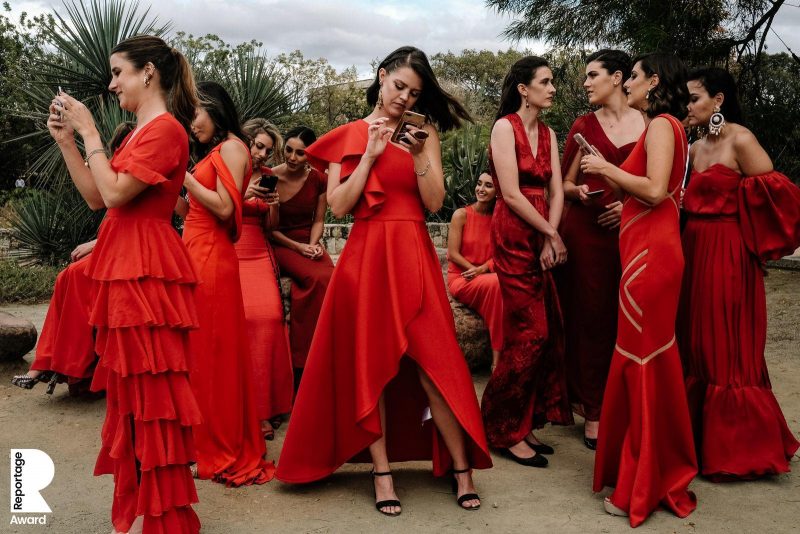
Alan:
Nor me, nor me.
Nikhol:
But he does a lot of that. And so, I think that compositionally like he learned composition through painting, right?
Alan:
Right.
Nikhol:
And I think he’s been able to apply that in an interesting way and the way he sees colours is quite interesting as well. And then for me from the psychology background, I studied psychology, my degree’s in Psychology and Holistic health. And I studied in San Francisco. And so, psychology, of course, is helpful, I think, for any area that anyone works in and just life in general. But it’s definitely, helped me and I think, Roque too, because I don’t stop talking about it. So, he’s learned a lot through that too and just his own, you know, process, if you will–
Alan:
Oh, that’s cool.
Nikhol:
–of self-discovery. Yeah. So we actually, we’ve only given two workshops, but the two workshops we gave, and we did a presentation at a conference in Chile, and we kind of developed our whole idea of what we do around psychology and integrating that in into photography and how it can be used as a tool within the context of the work we do. So, it’s definitely an integral part of our work.
Alan:
Yeah, and I can totally understand that as well. And you mentioned the workshop there and how did the workshops go? Do you get nervous doing that kind of thing or not?
Nikhol:
I was super nervous for the first one. Yeah, we did it here. So, they invited us, I don’t know if you’ve heard of the conference MACCHIA, it’s in Chile it’s a small conference in Concepcion, Chile. And so, we went in 2019 February, it was, in the beginning of February. And it was really cool. Before we did that, in December of 2018, we did a workshop here to practice because we’ve never done any like that and kind of test out if the material we were putting together and our theory of conscious photography was, you know, even interesting at all, and get feedback. So, we our first workshop was great. We had 20 people from different places in Mexico, mostly from Southern and Central Mexico. And so that was really fun. It was two days and enjoyed that. And then in Chile, it was just one day, and it was a full like 12-hour day and then.
Alan:
Wow, 12 hours, 12-hour day, that’s mental.
Nikhol:
So yeah, the Chile workshop was 12 hours, so that was intense because we had actually arrived that the night before we got into the hotel at like one in the morning then we woke up at six and gave a workshop from eight to eight.
Alan:
That is hard to be even just to be talking but long is strenuous. The extra stress of feeling like you because you really want to give something of value, don’t you when you do a workshop? It’s like really important. It’s pretty stressful.
Nikhol:
Yeah, yeah, I definitely had those moments. But also, I feel like it’s really exciting. Like, you know, because what I realized, the first time we talked was, I was definitely nervous the first time and I was and then I realized through the process, like, oh, I really know what I’m talking about. And so, it felt really good to be able to share something I’m passionate about and realize at the same time that I really understood what I was sharing, you know,
Alan:
That’s cool. Yeah, that’s cool, cool. Before COVID hit then, what was the typical wedding season like for you? Because I think you shoot a mix between Oaxaca in Mexico and also in California. Is that right?
Nikhol:
I shoot sometimes in California, but pretty rarely, mostly throughout Mexico.
Alan:
Okay.
Nikhol:
And our wedding season, I wouldn’t even say we have a season, like we definitely have a time where there’s more weddings, which would be the winter months here, which are from October, late October, until end of March.
Alan:
Okay.
Nikhol:
And then summer months, we have rain. So, from like, May-ish till early October, we have rain, so there’s less weddings, but we still have weddings. So I was, I mean, a typical season we’re shooting around, we try and keep it at 25 a year. And otherwise, we took a couple more one year and it was just in terms of editing, I was just overwhelmed. So, we decided to kind of try and keep it at 25.
Alan:
That’s a nice number.
Nikhol:
And so, this year we had, that’s a great number. Yeah, that’s great. I would even bring it down to like 20 sometime in the future, maybe in a couple of years after COVID recuperation happens. Yeah, but yeah.
Alan:
Yeah, yeah. How’s it been for you with COVID at the moment? What’s the situation like in Mexico? Can you even do weddings yet? Or what’s going on?
Nikhol:
No, we can’t do weddings yet, the country is still mostly in like highs alert but coming down. So, we’ve been basically home since mid-March and or maybe like around the 20th. I think we stopped going out and everything started closing. And we’ve gone out, you know, every once in a while, to the grocery store or like I do some I have a couple of photography projects that I shoot from our VW bug. So, we’ve done that but like places, like Oaxaca’s totally shut down. And especially the centro, the historic centre of the city is totally closed. There’s like, you can get to go but you can’t like go in. There’s nothing, no restaurants open, no hotels open.
Alan:
Right.
Nikhol:
But it has been challenging.
Alan:
Yeah, I bet, in terms of your wedding bookings and things have you been able to postpone and stuff to later on?
Nikhol:
Yeah, we’ve been able to postpone, so far, we haven’t had any cancellations. We’ve just had postponements, all for next year so far, we have three that supposedly are going to happen this year. So, we shot seven and we had we’ve had to postpone or reschedule 20, so we had 27 left. We shot 7 before it happened.
Alan:
Yeah, that’s a lot to postpone. Yeah, that’s … that’s so many to postpone. Wow, wow.
Nikhol:
Yeah. It was intense. So, in the beginning, I would say like the first one the postponement started happening it became I felt a little bit overwhelming, I really had to like check myself and find my centre and work from that space. A lot of like breathing activities and just you know, bringing myself to a balanced space where you can go into each postponement, you know a lot of people have a lot of questions and what happens if this and we added some things to our contract, to be a little bit more flexible for our clients, but also, you know, maintain our security in terms of offering a service, providing a service and, yeah, it’s been challenging, but we’ve been able to postpone almost all of them so now I kind of have a sense of relief and then we just have a couple that might happen this winter.
Alan:
Okay.
Nikhol: We’ll see what happens.
Alan:
That’s cool, that’s cool. You’ve been able to postpone. How did you feel when you realized the enormous, you know, impact of it. I just think it were me, I went through such a rollercoaster of emotions and it did hit me hard at one point, especially with my family, you know. How did you cope you know?
Nikhol:
Yeah, I think it’s a really emotionally triggering situation. I mean, I think we all have a lot of fear around economic security, of course, it’s a very rational fear to have but at the same time when that fear is prolonged, and we have, you know, the expression of fears is anxiety and so when we have that prolonged fear and prolonged anxiety, it can really affect our mental health and our physical health when we have high levels of stress in our body and anxiety. We have a lot of hormones that are circulating that can weaken our immune system, which doesn’t help the situation and you know and when you try to stay healthy as well in the context of everything that’s going on in the pandemic. I definitely had a lot of rollercoasters as well, you know, a lot of feeling, okay this is good, I got this, I can do this and then moments of just like feeling overwhelmed and having to you know, let myself feel that. I think it was definitely a rollercoaster for sure. And I think it still is, but it’s like less intense now. Right? Because it’s becoming like a new normal in a lot of ways.
Alan:
That’s true.
Nikhol:
So, we’re adapting, humans are very adaptable.
Alan:
That is true, isn’t it? It’s true. And yeah, and things are easing a bit. And I guess we’ll just see and hopefully next year, will be a bumper year as well, and yeah…
Nikhol:
How about you?
Alan:
Yeah, I mean, I went through, yeah. When I initially realized the huge, the huge devastating impact on everything, it was emotional for a bit and things, but then there have been benefits in terms of time to focus on other things, you know, and now it’s been lovely being at home with my kids a lot more. So, there have been some good sides, there definitely have. You mentioned earlier on–
Nikhol:
Yeah, they have, I totally agree with that.
Alan:
Yeah, yeah, definitely. It’s going to be okay. I’m feeling positive at the moment. It’s all good, it’s all good.
Nikhol:
Yes, exactly.
Alan:
You mentioned earlier on there about your VW bug. I can’t even say the word, your VW bug which I saw a photo of it I think on your website as well. Have you been able to be going out and about in that, at the moment? When COVID wasn’t around, did you travel a lot in that?
Nikhol:
Yeah, that’s actually the only car we have. So, we do travel. We don’t go long distances; we travel throughout the state of Oaxaca. So, Oaxaca has central valleys, it has the Sierra and then it has the coast as well. So, we tend to love to spend time in the different in the northern Sierras and the southern Sierras. And then we also love going to the coast. And so, we drive our bug there everywhere, we go really slow of course, takes a little bit longer to get everywhere. It’s not the safest car in the world. But yeah, we love it. It’s just the two of us and our dogs and so we fit perfectly and yeah, so when everything started, I just felt like I need to photograph something, I have a tendency to have a quite active mind.
And I think that’s reflected in my behaviour as well. I like to do things. And so, we wanted a project. And so, I started photographing my friends in quarantine from our bug, from our VW bug, when quarantine started here. So that was a big challenge, like finding ways different. You know, the first couple ones were like pretty easy, and I was like, I’m in the passenger seat, Roque’s in the driver’s seat and it’s just like our dogs are in the backseat. So, we try to integrate them to create a more interesting composition. But there’s only so much you can do when you’re parked in a small car, compositionally. So that’s good. It’s been a good challenge just to push myself to be creative and see things differently.
Alan:
Oh, that’s cool.
Nikhol:
Yeah. And then from there also, so that was one project and the other one was photographing a 10-block radius of the Centro Historico from our car, so Roque drives and I photograph, just to kind of see the change over time. It was interesting there were quite a few of the same people that I would see over and over again, and I would like to bring them prints when this is all done that would be cool if they can find them.
Alan:
That’s really cool.
Nikhol:
Yeah, it’s been a fun process.
Alan:
Well, that’s really cool. And the VW bug in general. It just sounds really romantic you two kind of just like, you know, kind of like road trip, it’s just sounds cool. It’s a cool thing to do. Cool. Let’s change tack slightly. Let’s go on to, are you a Netflix fan? or other streaming TV series fan?
Nikhol: Yeah, kind of.
Alan:
Yeah. You’re watching anything good at the moment?
Nikhol: We go in and out of Netflix, I feel like. We just started watching this series called Dark, it’s like a sci-fi series.
Alan:
I absolutely love Dark. I love it.
Nikhol:
Yeah, I thought it was at the beginning I was like took me a second to like get it. I feel like it was a little bit hard to like understand what was going on. And then all of a sudden, like we got it and we like watched the first season in like two nights.
Alan:
The final series came out yesterday, actually.
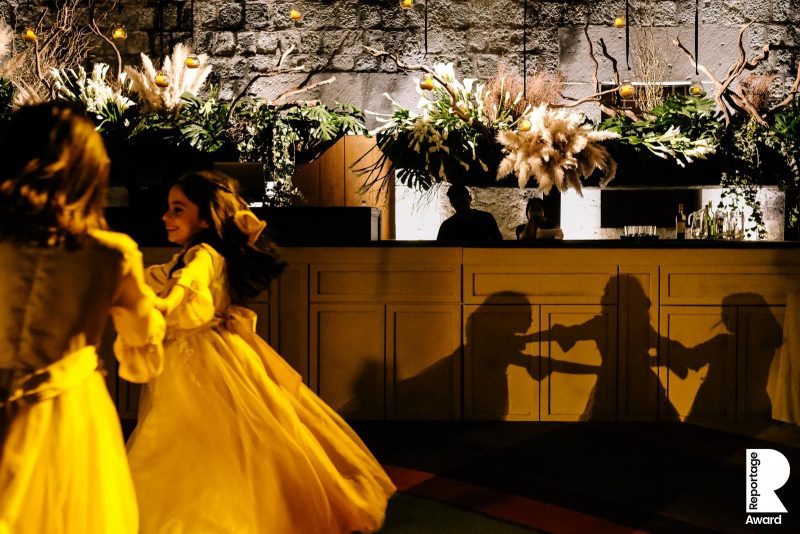
Nikhol:
I heard that. Yeah. So, we’re excited, we’re like, yes, we have something to watch. But we just finished watching before that, Mr. Robot which is like one of my all-time favourites. It’s phenomenal. I highly recommend that, it’s on Amazon. It’s brilliant. I mean compositionally, it’s just mind-blowing and beautiful, beautiful photography and just also the storyline, there’s kind of some parallels to the world situation right now–
Alan:
Oh, really? Oh okay.
Nikhol:
–But it’s a really good show. But we also watched on Netflix, a film recently I kind it’s called Ya no estoy aqui. I’m not sure in English and it’s a really great film about a young man in Northern Mexico and it’s just an interesting story. It’s just kind of like a story of a life, you know, one person’s life and it’s really was really well done. I also really enjoyed the photography in that and just kind of, I think it’s like hard to do a narrative with just without like a huge climax you know, it’s kind of just like a day in the life if you will. But of course, it’s not just one day, it’s a portrait of this gentleman’s life. So yeah, recommend that one I think I can’t remember what it’s called.
Alan:
Names always…
Nikhol:
Ya no estoy aqui.
Alan:
Oh, that sounds good, have to check that out, cool. With you mentioning Dark as well there, a random question but kind of linked to Dark. If you had a time machine or an apparatus, what time, past or future would you like to travel to?
Nikhol:
Oh, good question. Yeah, that’s definitely related to Dark. That’s a good segue. I would say, I don’t know, you know, I really got to say the other day, I was just thinking about the days when I first came to Mexico and I was just travelling, you know, just without a worry in the world and I remember riding to the coast of Oaxaca and you just get in the back of a colectivo, like a shared transportation truck and you just sit in it and they take you from like this little town near the coast out to the beach and those are some of the moments that I look back on with a lot of nostalgia and, and good feelings, and maybe like going back to that just for a little bit, maybe like half-hour.
Alan:
Yeah, that’s nice, that’s cool. Yeah. Where did you actually grow up then where’d you grow up originally?
Nikhol:
Yes, I’m from California from a place called Santa Cruz. It’s about an hour and a half south of San Francisco–
Alan:
Oh okay.
Nikhol:
–on the coast, so it’s like the central core of coast Northern California, people say both. And you have these small beach towns, very known for their surfing. I don’t know if you’ve heard of Mavericks, but it’s like a huge wave.
Alan:
Oh, I don’t know. But you know, I live in Cornwall in England where people surf but I’ve never surfed ever, never surfed.
Nikhol:
It must be cold there, no?
Alan:
Yes, exactly. Yeah, I don’t want to go in the water ever not even in a wetsuit, no. Do you like the water, are you in it often? Do you live near the coast right where you are?
Nikhol:
No, I don’t live near the coast. Oaxaca is actually super close to the coast. I think we’re only– I don’t want to get this wrong, I guess I’ll do it in hours because I know how much time it is, instead of distance. We’re only about if there was a direct road to the coast from Oaxaca City, it would be about a two and a half, three-hour drive. But because the road to get there, two-lane winding highway, you go all the way through the central valleys and then you go up through the southern Sierra and then you’ve come down to the coast and so because it’s such a windy road it’s about six and a half, seven hours.
Alan:
Oh okay. That’s a fairway.
Nikhol:
Yeah but it’s an incredible coast it’s not like big hotels or anything. It’s really like small like bungalow small hotels, like max, two storeys, you know.
Alan:
Oh okay, cool.
Nikhol:
Okay, so you can’t really build much higher here in Oaxaca because of earthquakes. We’re a seismic area. We actually just had an earthquake on Tuesday.
Alan:
Oh really.
Nikhol:
So that was intense, 7.5.
Alan:
Do you get them quite often then?
Nikhol:
The last big one we had was 2017 in September, I believe it was, and that was also 7.0. I don’t remember I don’t want to mistake, but I was in the sevens. So, it was big and that one caused a lot of damage in the Istmo region, the Isthmus of Oaxaca. And this one didn’t cause as much damage this one the epicentre was in Huatulco, which is a coastal town. And there was some damage in Oaxaca city, here we felt it really strong, but there wasn’t much damage. And in Oaxaca city, you can only build a certain height. I think two– three-storeys– two-storeys I think is it, is the max you can build because of that.
Alan:
Wow, that’s really interesting. You know, I’d never even thought about that. How they to have kind of limits on storeys and things. Wow, it’s mad. Well, we don’t really get them very often in Cornwall, I have to say, we really don’t.
Nikhol:
Do you have them at all?
Alan:
No, we don’t. We’re lucky that way. I guess that’s a good thing about England, you know, we don’t get very hot weather, but then it’s very temperate, you know we don’t get really cold weather. And we don’t you know, it’s very just kind of just on a level I think, which I quite like, it’s quite nice.
Nikhol:
Yeah.
Alan:
So, let’s get let’s go back to your photography, which is obviously awesome. And you’ve won five Story Awards, which is amazing. And you’ve won Reportage awards as well. But the Story Awards specifically, do you have any tips for people submitting to our stories? You know, what do you think is key to capturing you know, so much, so well, which is what you do, you know, that’s what Story Awards are awarding.
Nikhol:
Yeah, Story Awards are my favourite awards, to be honest, of all of that exists every time I see them, I guess I mean, yeah. Tips in terms of what to submit. I think that like, you know because some of the awards, the last two that we won actually the photos were both mine and Roque now that we’re both in the – I don’t know what to call it – the profile together.
Alan:
Yeah that’s cool. Yeah.
Nikhol:
Yeah. I don’t know, you know, I can’t really put it into the words that I’ve chosen, but like the New York wedding that one, I submitted it like four times before it won and every time I kind of switched out photos, and I started to see like, oh, it’s not the typical epic photo that needs to be in the story because that doesn’t connect the story correctly, right. So, I kind of had to go back and like refresh my mind and I judged a photo competition and I came back and I looked at it again, I kind of saw things differently. So, I think it’s coming back and like integrating things that you’re learning or things that you’re seeing and realizing what are the photos that are obviously has been a strong photograph, but also has to be a photograph that connects the narrative. Because if the narrative bounces all over the place, it gets a little bit confusing. And I think that an important part of that specific award is that there is a strong narrative and a thread, you know, narrative thread it that goes through in a way that makes sense, visually and otherwise.
Alan:
Yeah, Nikhol, I totally get that. Do you think when you started shooting together as a duo, did that, you know, really help you overall? How long were you shooting on your own for before you started shooting as a duo?
Nikhol:
So, my first wedding ever was, by myself was in… When was that? November of 2014–November 2013. And then 2014, I think I had three weddings. So, I didn’t really have any work. 2015 is kind of when it started for me and that’s when I think I shot like 12 weddings and then it just kept going up from there. So, I would say like really shooting from 2015 but my first wedding was on November of 2013.
Alan:
Right, okay cool.
Nikhol: And then we started shooting together in 2016.
Alan:
Oh okay, cool, cool and do you think, you know because I just find it interesting, you know hearing different people’s opinions on shooting solo or shooting as a duo. Do you think it has really really helped your coverage; you know shooting as a two-person team?
Nikhol:
Yeah for us I think it has like, Roque he’s obviously like– the process for anyone in this type of, in documentary photography or reportage as we say in American English.
Alan:
Oh cool.
Nikhol:
Because I remember when first heard you pronounce it, I was like, oh my god, yeah, it sounds so much better.
Alan:
I don’t know, there’s no right way is there so I’m probably saying it wrong. I don’t know.
Nikhol:
Yeah, but it sounds so much more elegant. And also, I don’t even know if reportage is right in American English, to be honest. I’m just guessing. But yeah, I mean, I think that shooting together has been really beneficial a lot of ways I really love to see how Roque’s vision has developed and how he sees and what he sees. I tend to have a little bit more of a stronger, not stronger, but like, you know, louder personality and Roque tends to be a bit quieter and introverted but an observer, he’s definitely a strong observer, so he’s seen a lot.
It’s interesting for me to see when I’m culling it’s like, what did he see within the moment? Especially when we’re shooting a similar moment, you know, and then I see what he saw and I see what I saw and it’s just such a reflection of who we are in our life experiences, right?
Alan: That’s so cool.
Nikhol: Yeah, I feel like you know when we shoot weddings, we’re not necessarily just shooting the wedding. We’re not just shooting their story, our story is going to be imprinted on there. It’s going to be reflected within the photos that we make. So, yeah, it’s interesting.
Alan:
Oh, that’s cool.
Nikhol:
Yeah, I’ve really enjoyed working together for our coverage, I feel like it’s definitely made a more complete coverage. Because we can photograph, more aspects like reaction and action, you know, speeches, it’s not like I have to be photographing the bride and groom, and reactions bride and groom, speech giver, you know, so you got to focus on one thing and be a little bit more creative within that and take a little bit more liberty to get some safe shots and then you try to take some risks and then he has the same option with, if he’s shooting reactions, for example.
Alan:
That sounds cool. So makes total sense. And yeah, as you say, I think that must be really interesting going through a cull and seeing sometimes images from the similar moment but seeing the different ways that you both capture it or the slightly different elements that you’ve captured of that moment. I think that’s so interesting. I do.
Nikhol:
Absolutely. It’s really interesting and there’s moments where I remember I was like, you know, trying to get his attention or something like, come over here and he’s ignoring me and I’m like why is he ignoring me and then like, I see the photo and I’m like, oh, that’s why.
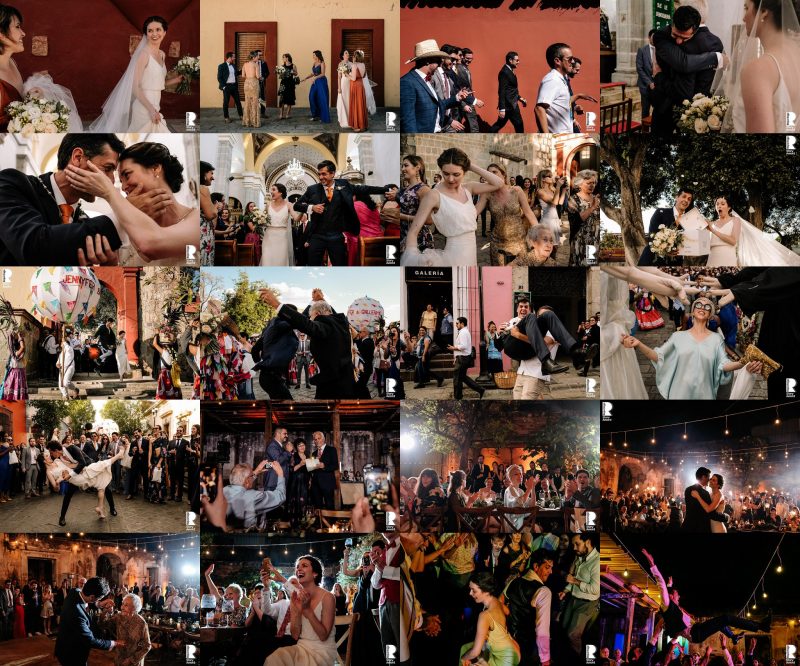
Alan:
That’s cool. You wrote a great ‘This is How’ piece for us a while ago where you talked exactly–
Nikhol:
Yeah, that’s right.
Alan:
–Yeah, you captured a certain shot which is awesome with the dog on the bride’s dress, and it’s a great read and if anyone’s listening to this, you know whilst running or something head to thisisreportage.com and I’ll include a link to it in this podcast transcript, which you’ll find there as well. But one quote, which I particularly love, and you said, “For me, when I first arrived and begin shooting a wedding, it’s important to get to know the people and animals present. It’s a time that allows for observation while shooting which can assist in being able to predict behaviours for future moments throughout the day celebrations,” which I think is such a great quote. Can you tell us a bit more about that and your approach there?
Nikhol:
I think when I first arrive there, I’m not like, okay, I’m ready to shoot and I’m going to make like a kick-ass photograph right now, you know, it’s like I get there and I’m aware that I’m going to, it’s like an exercise you know, I see it as like the vinyasa of my yoga practice, the sun salutations, if you will, within the context of yoga. So, you get there and it’s the warm-up, right? So, the warm-up includes not only shooting and kind of getting in a space to compose and see light. I think there’s a little adaptation phase there. And that’s what that is. And then also at the same time, it’s getting to know who these people really are, you know, we have conversations always with our clients beforehand, often we have destination weddings. So, it’s usually on a call. And, you know, we ask a lot of very specific questions that are specific to getting to know who they are as people, their story, the family dynamics, things that I feel like are important to be able to document, for us to document the way that we do.
And then for things to go smoothly as well at the same time, as smoothly as they can. And, but yeah, at the same time, you know, it’s a warm-up, to get to know them in person, because getting to know someone over the phone is totally different than in person. So, you just have to, I feel like for us, we get there we’re observing like their interactions, who they are, who everyone is. They’ve told us who everyone is and their names, but we don’t necessarily have a face. So figuring out, you know, doing those mental maps, and then at the same time, like warming up our mind and being able to be able to see these compositions coming together moments, light, and so yeah, I feel like when we first get there, it’s kind of a little bit of all of that mixed into one.
Alan:
That’s cool. Cool. Yeah. It’s great. I love hearing you talk about your approach and your work. It’s great. And yeah, as I say, people do head to the site, and I’ll include a link to that, ‘This is How’ piece because it’s a really great read. It’s brilliant. Okay, let’s go on to a question, I do ask this quite often, but I like this question and I just find this interesting, so. Yeah, what does it mean to be successful to you, you know, what is success to you, Nikhol?
Nikhol:
Yeah, that’s a great question. That’s a hard question.
Alan:
It is hard.
Nikhol:
Yeah, like success in general in life, I would say, you know, finding balance, finding inner peace, finding a space that feels like a good space to live life from. And then also I think the continual path of personal work and understanding who we are, what we’re doing. And that process, of course, like not every day doing this crazy self-analysis, but, you know, integrating it and having it be a part of your experience. And in terms of work, I mean, I think that success is relative right? To what our goals are in a moment. I don’t think that like, there’s a specific– I think it can change over time, and I think it can be static and evolve. I don’t think I necessarily, like have a specific idea in my head of what success means professionally. I know it feels good to be able to get weddings and book weddings and shoot them and it feels, of course, that’s a great feeling. But I don’t think that’s everything, right?
Alan:
Yeah, of course.
Nikhol:
Yeah, I think that’s a really hard and complicated question. I don’t know if I have an answer that would necessarily satisfy at this point in time.
Alan:
Oh no, you’re answering that. I think you’re answering that really well. I think as you say, it’s not something that’s static as well. It evolves all the time and yeah, it’s always very interesting. Yeah, it is, and you mentioned that you know, obviously, it does feel good having weddings booked in and it does because we get to feed ourselves as well and pay the bills and things.
Nikhol:
Right, exactly.
Alan:
What is the secret or what has been a good referrer of you know, a source of wedding bookings for you particularly, you know, do you put time into social media or you know, advertising, what’s key for you in getting in your bookings?
Nikhol:
Yeah, we get quite a few bookings through Instagram.
Alan:
Oh cool.
Nikhol:
So people looked at specific hashtags, Oaxaca doesn’t have–like our wedding industry in the last two years really blew up here for destination weddings, right now it’s on pause obviously, but so there wasn’t that many photographers here and there’s more like, every year, but there weren’t that many. And so, Instagram was a good using specific hashtags. People really looked for those to look for vendors, and then Google and wedding coordinators here. So, we work with quite a few local wedding coordinators who are wonderful, and we’re really lucky, yeah, to have a solid wedding community here, small and solid.
Alan:
That’s cool.
Nikhol:
Oaxaca’s a small city.
Alan:
With your wedding coordinators that you mentioned there. Did you proactively ever, you know, reach out to them to arrange a working relationship or is it just after you’ve shot a wedding with them, then they recommend you, you know, was it a natural thing or how did that happen?
Nikhol:
Yeah, I would say it’s more the latter that after working together, you know, I would, of course, give them photographs and say like, or, you know, share the gallery with them and let me know if you guys want some photographs and give them photographs to use on their website and their social media, and then at the same you know, I think that they realize also like we turned in our work on time, we communicate a lot with our clients, they don’t have to do anything for us and I think that’s less work for them as well, right?
Alan:
Yeah. That’s so true.
Nikhol:
Yeah, so I think they’ve valued that some, but also the just like we have good working relationships and pretty solid connection with most of them.
Alan:
That’s cool. Yeah, personable skills, you know, just interpersonal skills are so important in life and in business.
Nikhol:
Yeah so important. Yeah, I absolutely agree with that.
Alan:
So, a lot of the couples maybe that you shoot, the first meeting is it via Skype a lot of the time then?
Nikhol:
Yeah, most the time is yeah, via Skype, Zoom, WhatsApp, Video call of some sort. Yeah, so that’s usually our first meeting. We definitely require that, we’ve had a couple weddings in the past, where was like it just was not able to happen; a video call, we were like, hey, but we need to have a call, you don’t want to be on video, that’s fine.
Alan:
Yeah.
Nikhol:
But we have to talk. Because yeah, most of them aren’t in Oaxaca, they’re in other places of Mexico or other countries. So yeah, we definitely require calling, it’s usually a video call.
Alan:
And how do you get on with those video calls? Have you got any tips because I just know some people find skypes or video calls, it’s very nerve-racking or you know, don’t really know how to approach them. How do you approach those kinds of meetings with clients?
Nikhol:
Yeah, I love them to be honest. I’m like, super stoked as soon as I get on the call and like yes! Let me tell you about what we do because I’m excited about it.
Alan:
That’s cool.
Nikhol:
But I usually like you know, I have a format that I follow, like, introduce myself, ask them some questions about who they are, you know, about their wedding where it’ll be where, you know, why Oaxaca or why other places in Mexico and then from there, I just kind of put some structure to it. Okay, well, I’m going to tell you guys a little bit more about what we’ve done. Some of the things that, you know, gone over in the email, but just to like, you know, further elaborate, and then you guys can, then we’ll have time where you guys can ask me any questions, and then we can just kind of take it from there. But I definitely try and put in the beginning a structure, so they understand anything else further along in the conversation that I might refer back to.
Alan:
Oh, makes sense. Good, good. Good advice. That’s cool. Cool. What’s the most bizarre or funniest thing that you’ve seen at a wedding?
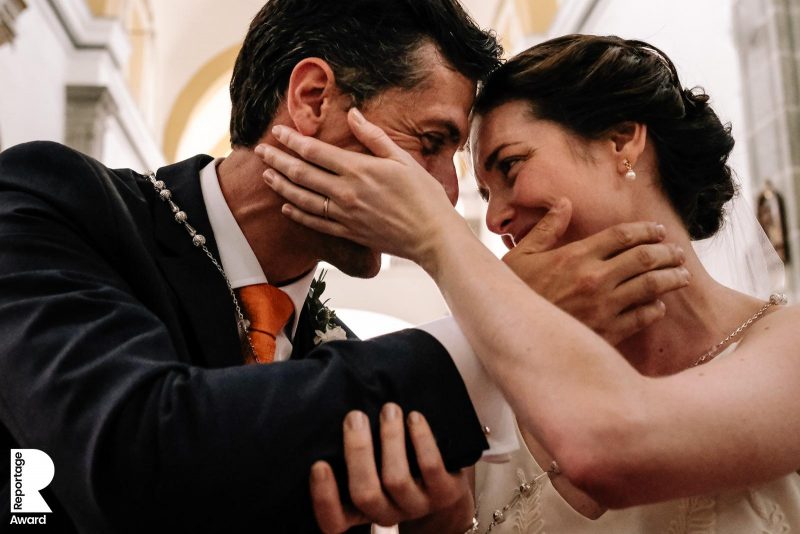
Nikhol:
Oh, good question. I mean Oaxaca weddings can be really elaborate. So, it can be like a lot of fireworks, we have something called the Calenda, it’s a traditional street parade but adapted to more modern wedding contexts. So, it’s like, I don’t know, have you ever seen a wedding in New Orleans or been to New Orleans by any chance?
Alan:
I’ve never been, no I’d love to. But no, no.
Nikhol:
It’s a cool city. They have something similar called a second line, which is like a brass band parade in the street for celebration as well during like Mardi Gras, and then they’ve adopted into weddings as well or maybe already was in weddings. I actually don’t know the history of it that specifically, but it in Oaxaca we have a similar thing where it’s right after the ceremony the Calenda, it’s like traditional dancers in their clothing and then a band as well. And so, they play music in the street and dance in the street and the rest of the wedding goes with them dancing as Mezcal, and it takes you from the ceremony to the reception.
Alan:
Wow, that’s very cool. Is that most of the weddings you shoot have that, then do they?
Nikhol:
Oh, yeah like 99%.
Alan:
Oh, wow. That’s cool.
Nikhol:
Yeah. It’s a really cool experience. It’s really fun like, people will be like, oh, because most guests don’t know about it beforehand, even if they do know, they don’t understand what it is. And so afterwards they’re always just like, oh my god, that was so cool.
Alan:
That’s cool, isn’t it? As you know, what a job that we have. And you have that you’re experiencing something like that, you know, a lot of weekends. It is very cool, isn’t it? We see so many different things in this job. It is cool.
Nikhol:
Yeah it is, it really is. Yeah, it can be highly addictive.
Alan:
One of your images is like a jumping dog. Is that from that kind of time?
Nikhol:
Yeah, yeah, that’s exactly right. So that dog’s called Marzipan, we actually had this elopement, it was like a really small wedding/elopement of like seven guests or something. And it was in May of 2018 was it or was it ’17. I think it was ’18, 2018. And that was the first time we saw him. He was a street dog. And he was like–because in the Calenda there’s also fireworks, so the dancer has a fireworks construction on their head in a basket, and they dance with it, and there’s fireworks that go off. And so, Marzipan would like jump up and whenever the fireworks would go off, and like try and get the fireworks, he would just jump and it would look like he was dancing, he would do 360s.
Alan:
That’s cool.
Nikhol:
And so, he became super famous. And we have a festival in Oaxaca called La Guelaguetza where the different regions of Oaxaca are represented, their culture and dancers are represented and in a dance festival that’s during two weekends and then you have parades in the streets. It’s cancelled this year and because of the pandemic, but it’s usually in July. And so, he got even more famous when he was dancing in the Guelaguetza Calenda and so then after that, we started seeing him in tons of weddings and last year, 2019 or was it 2018, both 2018, ’19. And then he got adopted, luckily, and then, you know, hasn’t been out in the street since Day of the Dead of last year. Because, you know, it’s stressful for the dancers when they’re trying to dance with fireworks on their head, and then there’s a dog jumping up on them.
Alan:
Yeah, I can imagine that’s quite a stressful situation.
Nikhol:
Yeah, so they asked for him to like not be present because it was you know, it was getting dangerous for them sometimes, he wasn’t trying to bite them, but like he was a big dog. So, he was adopted, which is awesome. He’s very fortunate to be adopted. And so, we haven’t seen him on the streets maybe since November or October of last year.
Alan:
Well, that’s cool, he’s got a home then. That’s oh, that’s cool and it’s a great image that is and that’s yeah, it’s cool–
Nikhol:
Yeah, I love that dog.
Alan:
–Yeah, it’s cool that you’re seeing something like that. So, it’s really cool. Nikhol, has there been a specific kind of turning point in your career, you know, something, perhaps a certain wedding or an award or anything that’s had a major impact on in your career or at all?
Nikhol:
Oh, yeah, well I feel like there were lots of moments like that have happened, or it was just like had a click or something suddenly made sense. I don’t know. I can’t give you an exact date. But like, I remember the moment of when like, all of a sudden, my brain was saying composition definitely, like the components coming together like a puzzle, kind of, you know, and being able to see like, how to compose, how to clean up the backgrounds in the moments and being able to actually execute that. I would say that’s probably like 2018-ish, end of 2018 or maybe earlier, I don’t know but being able to see that all happening in the moment. I think that was a big, my moment.
Alan:
Did that come just come just from kind of constant practice, or did you go to certain workshops or anything, did that just evolve to that kind of moment?
Nikhol:
I think it was just practice, like I practice a lot, during normal times. I would, you know, I shoot in the street at least once a week. And then I photograph our dogs a lot at our house, try to make interesting photos of dogs which is really hard for me to do. I try and yeah, I mean, I think the practice I think it’s just the practice like there’s this quote that’s used in yoga, “Practice and all is coming,” and I think the same can be applied to any endeavour really whether it be athletic or whether it be you know creative. Not that there’s not creativity in the athletic area but yeah, at the end you know, it apply to everything and all the sudden I have the same thing in my yoga practice is that every practicing, practicing the same series over and over and all of a sudden, I could just do it, you know, this posture that I was like, oh, wait a sec. I couldn’t do that, you know, yesterday. And I think the same thing happens with me with photography, I found the more and more I practice, I just have these moments where all of the sudden, it just happens.
Alan:
That’s cool.
Nikhol:
And yeah, and I feel like that’s happened recently for Roque too in the last like year. Maybe no, that’s like 2019 for him all of a sudden like I was like, whoa, that composition whoa, whoa, it’s getting a lot more complicated when he’s cleaning his background, he’s like seeing what’s going on behind everything, in the moment while he’s composing. And I was just like, yes.
Alan:
That’s cool. That’s very cool. Yeah, I love that. I love that about what we do because it is, you know, it is kind of creating pieces of art on the fly. I know that sounds pretentious, but it is it’s so difficult to do. And when—
Nikhol:
Oh, it is. It’s so hard.
Alan:
–That finally clicks, it’s so rewarding, yeah, I love it.
Nikhol:
It really is. Yeah, it’s like that dopamine hit, you know, I’m just like, yes.
Alan:
Yeah.
Nikhol:
I keep on doing this, you need that reward to continue.
Alan:
Definitely. And as well as your wedding work, you also shoot families in a documentary way as well.
Nikhol:
Right.
Alan:
I’ve seen your family work, which is awesome. Can you tell us about your family side?
Nikhol:
Yeah, I love it. I mean, I do the same exact thing. I have the same exact approach to families. I don’t shoot that much in Mexico actually, like hardly any.
Alan:
Oh, okay.
Nikhol:
And I wouldn’t say there’s that big of market here in Oaxaca for that style of photography.
Alan:
Right.
Nikhol:
Within the family context, there is for weddings, but not so much for family. And so I shoot when I go home to California, I have families that I shoot every year, a lot of people I grew up with. And yeah, I just go into the same approach. Of course, like it’s real. I learned the hard way, not the hard. I mean, it wasn’t I didn’t get myself into a bad situation. But I remember like, one of the first sessions I arrived to, she was like, well, what do I do? What should I? And I was like, I did not tell you anything ahead of time, did I? My bad, so I learned that the education part is important, which is something we do in weddings. They have to also, of course, do the family context.
Alan:
Yeah, that makes sense.
Nikhol:
So yeah, we definitely do a lot of education around what we’re doing, you know, try to make them feel as comfortable as possible. And then actually, Roque doesn’t do families, I just do it. So, I go in and I shoot with the same approach and usually, I say my average family sessions are around 2 to 4 hours.
Alan:
Oh, okay.
Nikhol:
The longest one I’ve ever had was like 10 hours, which was awesome.
Alan:
Wow. Yeah, cool.
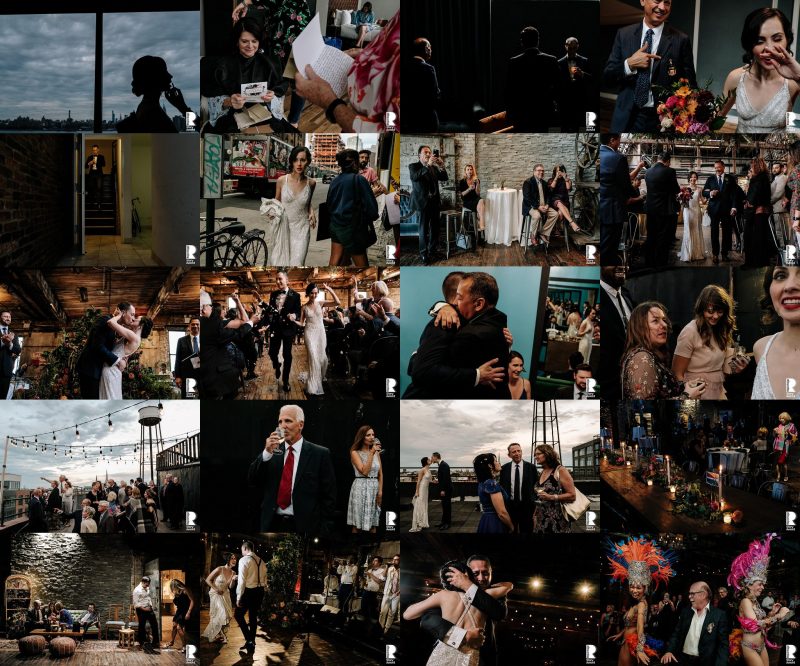
Alan:
Wow. Man, yeah, that’s mad. Cool. That’s, I think, I love it. It’s great hearing from you how you just approach it exactly the same way. Cause it’s still just about capturing those natural, you know, unposed moments, isn’t it?
Nikhol:
Yeah, yeah. And yeah, you know, that’s exactly what it is. It’s a good training as well for the mind for how to see and learning to see in different light in different contexts. It’s generally you know, weddings tend to be a little bit more, like, you know, prepared visually, like, you know, decorations and spaces and–
Alan:
That’s true.
Nikhol:
–And things like that. Like, I’d say the closest, in a wedding context to be the getting ready time. And that would be the closest that has like the most in common with the family session. Cause it can be quite chaotic and stuff everywhere and people aren’t in makeup yet necessarily or anything.
Alan:
That’s true.
Nikhol:
So yeah, there’s a lot of things, similar things and a lot of different aspects as well.
Alan:
That’s cool. That’s very cool. And yeah, I love the work that I’ve seen of yours. It’s awesome. It’s awesome, going back to weddings, what advice, you know, would you give for people who have been shooting for, you know, for quite a few years, maybe five, six, seven years or more, and are just, you know, maybe not that happy with their work or just not that happy with the points in their career that they’re at the moment, you know, would you have any advice for them?
Nikhol:
Yeah, I mean, I don’t know. I haven’t thought about that before. It’s a good question. And I guess like something for me personally when I’ve been in those spaces, and just like, looking at the work I’m producing and maybe other people are loving it, but I’m not and I’m not feeling motivated by or inspired by it. I’ve found that looking more at me as a person, personal things that are coming up for me personally. Again, going back to the to the personal work, and kind of going back into that space to try and you know, maybe there’s some things that I need to address there. And then from there, there can be some changes within my work, I think they’re really connected.
But also of course, like within the context of photography, we’re feeling bored by it or not inspired by it. I think part of it could be you know, taking an introspective look at yourself, in the present and maybe aspects of the past I think that trauma is always you know, coming in waves into our present life, and then can affect us in a lot of ways and in creativity, creativity as well can be affected. So, I think that’s one part and then I think the other part is like, try something new, you know, take some risks, do something maybe you haven’t done before. Go out and shoot in the streets. That helps me a lot. Like when I’m feeling overwhelmed or, you know, anxiety with work or just a lot of work or stress, I often will, I do a lot of breathwork, but I also like to just go out in the street and shoot and kind of find the pattern because I don’t know if you have this experience, but I always have it in weddings like the warm-up phase is like so, it’s such an aware space for me, it’s probably the most present that I am during the wedding is like during the warm-up. And then once I get my rhythm, it’s like, you know peak performance with athletes. It’s like then you get into a physical, mental, psychological rhythm where you’re, I feel like, it’s like of course, it’s waves. It’s not just like up, up, up get to peak creativity and then down, you know, it’s like I feel like it’s weddings are longer than then generally like running a marathon, for example.
Alan:
That’s true.
Nikhol:
Well, I don’t know actually, I’ve never ran a marathon.
Alan:
No, Nor me.
Nikhol:
It’s very long as well. Yeah.
Alan:
I hate running. Oh, I hate running.
Nikhol:
I hate running too. I used to run actually, used to be a runner in college and high school. I ran a lot, but not anymore.
Alan:
Oh, okay. What kind of distances did you use to do? What long or short distances or?
Nikhol:
I mostly do sprints.
Alan:
Oh, okay. Yeah, that’s more manageable, although it’s still running…
Nikhol:
Yeah, yeah you going to get it over with it faster, it’s benefit.
Alan:
Okay, let’s go to a lighter question, Nikhol, let’s go to a lighter question. What is something that you hate but that most people seem to love?
Nikhol:
Oh, interesting. Actually, I haven’t–I know exactly my answer, olives.
Alan:
Oh, really? Yeah.
Nikhol:
Yeah. I mean in terms of fearing and that’s the first thing that comes to mind, I can’t stand olives, really just can’t deal with them. So…
Alan:
Super-strong taste. They take over everything if you have an olive on a piece of pizza.
Nikhol:
They take over anything. I can’t deal, I actually one time, I posted this thing on Facebook. I think it was like four or five years ago and I was like, olive haters. And I was like, oh my god, this is a thing. I posted it and then a friend of mine, who’s from a place in Spain where they’re like, super famous for their olives. He wrote me and he was like, Yeah, well, you have not been to my village cause in my village you would love olives. He got quite offended by it.
Alan:
That’s funny. That’s a good answer. I think olives is a good answer, and I am with you on that one.
Nikhol:
Thanks.
Alan:
Let’s go to another one. That’s not such a light question. But again, something that I really like and find really interesting is, what is happiness to you? Nikhol? Yeah, what is happiness?
Nikhol:
That is another interesting one. So, happiness is a lot of things. I think, again, I think it’s could be a relative term. I think it’s open to interpretation. I think that it has a lot to do with our context, right? Like how we’re going to define happiness depends on maybe a bit of what we have and what we don’t, and you know, the idea of needing something that we don’t have that I think that can take away from happiness. I think maybe it’s like, a more of a physical state that influences a mental state, a psychological state, and vice versa, maybe. In terms of like naming specific things. I don’t know what happiness is, for me I feel, happy when I’m creating for sure. I feel happy making photographs. I feel happy with the challenge of creating in general and then also specifically within the context of photography, I feel happy in my yoga practice for sure. It’s been definitely something that’s been really helpful for me during the pandemic–
Alan:
I like that.
Nikhol:
–Keeping me balanced. But again, I think it’s a relative thing. I don’t think I have like, an answer of what happiness is specifically, I think, I experience moments of happiness throughout my life and I’m very grateful for that. And yeah, I think it’s an evolutionary and that’s not the right word. I think it’s a state that you go in and out of, and experiences and I think a lot of the time like, you know, like a lot of times are like, oh, this thing made me so happy or this experience made me so happy. And I think that often also they’re connected to past experiences because I think a lot of like, how we interpret and experience our present, is a reflection of experiences that are maybe subconscious experiences, —
Alan:
Okay.
Nikhol:
–But that brought us joy at some point. The way we would define happiness, it’s like over time, right? It’s not like you’re born with an idea of happiness.
Alan:
Yeah.
Nikhol:
And then, I can from come experience and I can also come from like the outside world and conditioning and social conditioning and influence and yeah, I don’t know. If that makes sense.
Alan:
No, it’s great. Yeah, no, that was great. It’s honestly, so interesting, so interesting. I think that’s great. Cool. Nikhol, I’ve got time for just one last question. This has been, it’s been so lovely talking to you. Thank you so much. So, your work is ace, I’ve loved your work since the first time, I’ve seen it
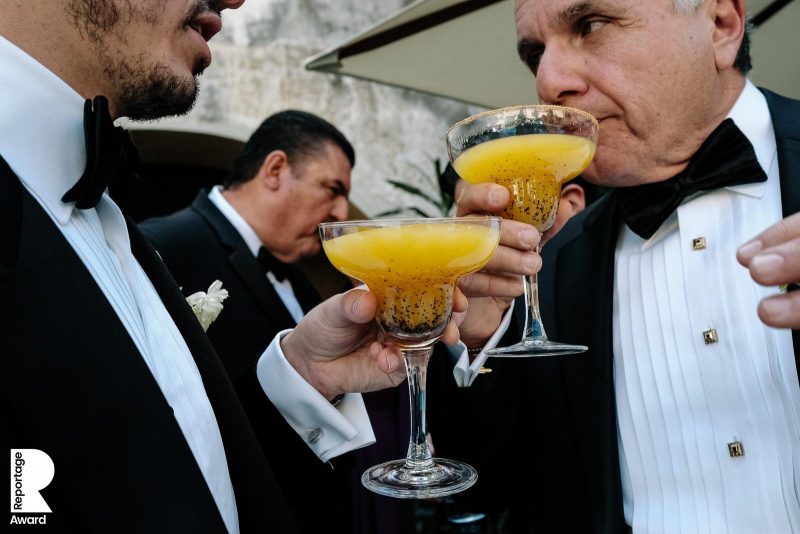
Nikhol:
Thank you.
Alan:
So, let’s for the final question, what would be your top tips to help someone get better at the documentary side of wedding photography, specifically?
Nikhol:
I have to say practice, that’s like, for me, it’s been everything. I’m speaking again, from my personal experience. And I would say practice is everything, practice and through practice, you know, not just going out and shooting but going out and shooting and really taking a look at your photographs and what worked and why like, why did I? You know, question, why did I shoot that if that photograph doesn’t work when I look back on it, there’s nothing I took that day on the street, which happens to me, you know, I’ll shoot for two hours in the street and we’ll come back and like nothing works, I’m just like, what was I thinking? How did I not see that light pole, you know, that lamp coming out of that guy’s head. And so, once I’ve seen that you know that I wasn’t even paying attention to my background. Okay, so I’m going to go back out tomorrow and I’m going to practice I’m going to focus on cleaning my backgrounds, you know, so I think that, that learning that aspect of it. And then also I think, the other important part in terms of documentary photography is definitely taking the time to get to know who you’re photographing and who they are and, and also not imposing your narrative on their wedding story. I think it can happen sometimes you know, of course during like the newlywed photos, which we do, during that newlywed photo time or just couple time, however, you want to call it the way we direct and when we tell them where to stand and all that. But there’s a lot of moments that are happening in between, that I think that we need to also like pay attention to and photograph. But yeah, I mean, fine. We don’t impose narrative apart from that, from that time–
Alan:
Oh, I see, yeah.
Nikhol:
–And then and also during the family photos, like the formals. I’ll photograph them and then Roque, be photographing what’s going on around. But other than that, I think it’s really important that like we, you know, we have moments like where like the bride is walking and maybe like, she drops her flowers and you want to rush into help it’s like no step back. You have to train your brain sometimes because we have an automatic, unconscious reaction to go and help, right?
Alan:
That’s true.
Nikhol:
To make life easier for the bride where, you know, and often, I mean, I’ve done in the past many times where I’ll go in and try and intervene and I’m like, I had to train myself like no, let her struggle. She’s got this, she can pick up her bouquet and it’s going to be a great photo. It could be a great photograph because I didn’t go and try to intervene. And then there were moments that I can remember where I went and intervened and I was like, oh, man, I missed a moment now. You know. So, of course, that came from practice. And I think that that practice is important, for me I do most like I mentioned, mostly at practice in street photography, and then stuff here at my house with my husband and our dogs and neighbours. And yeah.
Alan:
That’s cool. Oh, I think that’s brilliant advice, brilliant advice. Oh, Nikhol, thank you so much.
Nikhol:
Yeah, thank you.
Alan:
It’s been honestly, oh, no, thank you for your time and openness and knowledge there, and just sharing, it was brilliant. Thank you. Yeah, if anyone’s listening to this, there’ll be, head to thisisreporatge.com. If you’re listening whiles running, you know, you might be one of those people that actually like to run.
Nikhol:
Yeah. I love that.
Alan:
Yeah, no offence, no offence at all. Yeah, head to thisisreportage.com I’ll include lots of examples of Nikhol’s work and link to her website and ‘This is How’ piece as well. And yeah, thank you so much. Hopefully, I’ll get to meet you one day. That’ll be cool.
Nikhol:
Yeah, thank you. I really enjoyed the conversation and I hope to meet you too.
Alan:
Oh yeah. And you, stay safe. Thanks so much, Nikhol that was fab.
Nikhol:
You too. Have a good one.
Alan:
Bye-bye.
Nikhol:
Bye.
***********************************************************
We hope you enjoyed our Nikhol Esterás interview!
View more of her work on her website or here on her This is Reportage profile. The ‘This is How’ post she wrote for us is over here, too.
Interested in joining us? Find out all the benefits and become a member.
